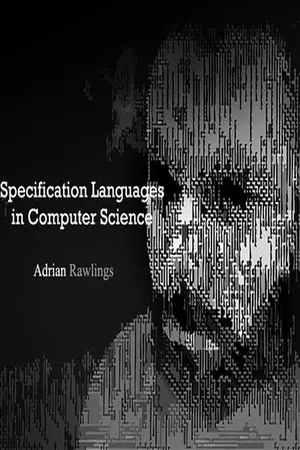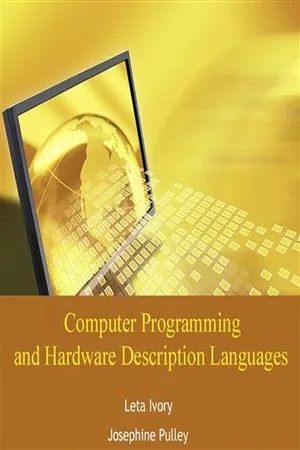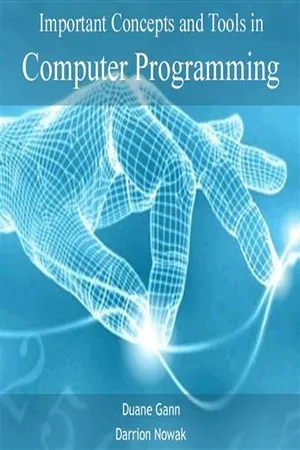Computer Science
Programming Languages
Programming languages are formal languages used to communicate instructions to a computer. They allow programmers to write code that can be understood and executed by a computer. Each programming language has its own syntax and semantics, and different languages are suited to different types of tasks and applications.
Written by Perlego with AI-assistance
Related key terms
1 of 5
10 Key excerpts on "Programming Languages"
- No longer available |Learn more
- (Author)
- 2014(Publication Date)
- Research World(Publisher)
____________________ WORLD TECHNOLOGIES ____________________ Chapter 14 Programming Language A programming language is an artificial language designed to express computations that can be performed by a machine, particularly a computer. Programming Languages can be used to create programs that control the behavior of a machine, to express algorithms precisely, or as a mode of human communication. The earliest Programming Languages predate the invention of the computer, and were used to direct the behavior of machines such as Jacquard looms and player pianos. Thousands of different Programming Languages have been created, mainly in the computer field, with many more being created every year. Most Programming Languages describe computation in an imperative style, i.e., as a sequence of commands, although some languages, such as those that support functional programming or logic program-ming, use alternative forms of description. A programming language is usually split into the two components of syntax (form) and semantics (meaning) and many Programming Languages have some kind of written specification of their syntax and/or semantics. Some languages are defined by a specification document, for example, the C programming language is specified by an ISO Standard, while other languages, such as Perl, have a dominant implementation that is used as a reference. Definitions A programming language is a notation for writing programs, which are specifications of a computation or algorithm. Some, but not all, authors restrict the term programming language to those languages that can express all possible algorithms. Traits often considered important for what constitutes a programming language include: • Function and target: A computer programming language is a language used to write computer programs, which involve a computer performing some kind of computation or algorithm and possibly control external devices such as printers, disk drives, robots, and so on. - No longer available |Learn more
- (Author)
- 2014(Publication Date)
- Academic Studio(Publisher)
________________________ WORLD TECHNOLOGIES ________________________ Chapter 1 Programming Language A programming language is an artificial language designed to express computations that can be performed by a machine, particularly a computer. Programming Languages can be used to create programs that control the behavior of a machine, to express algorithms precisely, or as a mode of human communication. The earliest Programming Languages predate the invention of the computer, and were used to direct the behavior of machines such as Jacquard looms and player pianos. Thousands of different Programming Languages have been created, mainly in the computer field, with many more being created every year. Most Programming Languages describe computation in an imperative style, i.e., as a sequence of commands, although some languages, such as those that support functional programming or logic prog-ramming, use alternative forms of description. A programming language is usually split into the two components of syntax (form) and semantics (meaning) and many Programming Languages have some kind of written specification of their syntax and/or semantics. Some languages are defined by a speci-fication document, for example, the C programming language is specified by an ISO Standard, while other languages, such as Perl, have a dominant implementation that is used as a reference. Definitions A programming language is a notation for writing programs, which are specifications of a computation or algorithm. Some, but not all, authors restrict the term programming language to those languages that can express all possible algorithms. Traits often considered important for what constitutes a programming language include: • Function and target: A computer programming language is a language used to write computer programs, which involve a computer performing some kind of computation or algorithm and possibly control external devices such as printers, disk drives, robots, and so on. - No longer available |Learn more
- (Author)
- 2014(Publication Date)
- Research World(Publisher)
____________________ WORLD TECHNOLOGIES ____________________ Chapter 1 Programming Language A programming language is an artificial language designed to express computations that can be performed by a machine, particularly a computer. Programming Languages can be used to create programs that control the behavior of a machine, to express algorithms precisely, or as a mode of human communication. The earliest Programming Languages predate the invention of the computer, and were used to direct the behavior of machines such as Jacquard looms and player pianos. Thousands of different Programming Languages have been created, mainly in the computer field, with many more being created every year. Most Programming Languages describe computation in an imperative style, i.e., as a sequence of commands, although some languages, such as those that support functional programming or logic programming, use alternative forms of description. A programming language is usually split into the two components of syntax (form) and semantics (meaning) and many Programming Languages have some kind of written specification of their syntax and/or semantics. Some languages are defined by a specification document, for example, the C programming language is specified by an ISO Standard, while other languages, such as Perl, have a dominant implementation that is used as a reference. Definitions A programming language is a notation for writing programs, which are specifications of a computation or algorithm. Some, but not all, authors restrict the term programming language to those languages that can express all possible algorithms. Traits often considered important for what constitutes a programming language include: • Function and target: A computer programming language is a language used to write computer programs, which involve a computer performing some kind of computation or algorithm and possibly control external devices such as printers, disk drives, robots, and so on. - No longer available |Learn more
- (Author)
- 2014(Publication Date)
- Academic Pages(Publisher)
________________________ WORLD TECHNOLOGIES ________________________ Chapter- 11 Programming Language A programming language is an artificial language designed to express computations that can be performed by a machine, particularly a computer. Programming Languages can be used to create programs that control the behavior of a machine, to express algo-rithms precisely, or as a mode of human communication. The earliest Programming Languages predate the invention of the computer, and were used to direct the behavior of machines such as Jacquard looms and player pianos. Thousands of different Programming Languages have been created, mainly in the computer field, with many more being created every year. Most Programming Languages describe computation in an imperative style, i.e., as a sequence of commands, although some languages, such as those that support functional programming or logic program-ming, use alternative forms of description. A programming language is usually split into the two components of syntax (form) and semantics (meaning) and many Programming Languages have some kind of written specification of their syntax and/or semantics. Some languages are defined by a speci-fication document, for example, the C programming language is specified by an ISO Standard, while other languages, such as Perl, have a dominant implementation that is used as a reference. Definitions A programming language is a notation for writing programs, which are specifications of a computation or algorithm. Some, but not all, authors restrict the term programming lan-guage to those languages that can express all possible algorithms. Traits often consi-dered important for what constitutes a programming language include: • Function and target: A computer programming language is a language used to write computer programs, which involve a computer performing some kind of computation or algorithm and possibly control external devices such as printers, disk drives, robots, and so on. - No longer available |Learn more
- (Author)
- 2014(Publication Date)
- White Word Publications(Publisher)
________________________ WORLD TECHNOLOGIES ________________________ Chapter- 11 Programming Language A programming language is an artificial language designed to express computations that can be performed by a machine, particularly a computer. Programming Languages can be used to create programs that control the behavior of a machine, to express algorithms precisely, or as a mode of human communication. The earliest Programming Languages predate the invention of the computer, and were used to direct the behavior of machines such as Jacquard looms and player pianos. Thousands of different Programming Languages have been created, mainly in the computer field, with many more being created every year. Most Programming Languages describe computation in an imperative style, i.e., as a sequence of commands, although some languages, such as those that support functional programming or logic programming, use alternative forms of description. A programming language is usually split into the two components of syntax (form) and semantics (meaning) and many Programming Languages have some kind of written specification of their syntax and/or semantics. Some languages are defined by a specification document, for example, the C programming language is specified by an ISO Standard, while other languages, such as Perl, have a dominant implementation that is used as a reference. Definitions A programming language is a notation for writing programs, which are specifications of a computation or algorithm. Some, but not all, authors restrict the term programming language to those languages that can express all possible algorithms. Traits often considered important for what constitutes a programming language include: • Function and target: A computer programming language is a language used to write computer programs, which involve a computer performing some kind of computation or algorithm and possibly control external devices such as printers, disk drives, robots, and so on. - No longer available |Learn more
- (Author)
- 2014(Publication Date)
- College Publishing House(Publisher)
________________________ WORLD TECHNOLOGIES ________________________ Chapter 2 Programming Language A programming language is an artificial language designed to express computations that can be performed by a machine, particularly a computer. Programming Languages can be used to create programs that control the behavior of a machine, to express algorithms precisely, or as a mode of human communication. Many Programming Languages have some form of written specification of their syntax (form) and semantics (meaning). Some languages are defined by a specification docu-ment. For example, the C programming language is specified by an ISO Standard. Other languages, such as Perl, have a dominant implementation that is used as a reference. The earliest Programming Languages predate the invention of the computer, and were used to direct the behavior of machines such as Jacquard looms and player pianos. Thousands of different Programming Languages have been created, mainly in the computer field, with many more being created every year. Most Programming Languages describe computation in an imperative style, i.e., as a sequence of commands, although some languages, such as those that support functional programming or logic program-ming, use alternative forms of description. Definitions A programming language is a notation for writing programs, which are specifications of a computation or algorithm. Some, but not all, authors restrict the term programming language to those languages that can express all possible algorithms. Traits often considered important for what constitutes a programming language include: • Function and target: A computer programming language is a language used to write computer programs, which involve a computer performing some kind of computation or algorithm and possibly control external devices such as printers, disk drives, robots, and so on. - No longer available |Learn more
- (Author)
- 2014(Publication Date)
- College Publishing House(Publisher)
________________________ WORLD TECHNOLOGIES ________________________ Chapter 1 Introduction to Programming Language A programming language is an artificial language designed to express computations that can be performed by a machine, particularly a computer. Programming Languages can be used to create programs that control the behavior of a machine, to express algorithms precisely, or as a mode of human communication. Many Programming Languages have some form of written specification of their syntax (form) and semantics (meaning). Some languages are defined by a specification document. For example, the C programming language is specified by an ISO Standard. Other languages, such as Perl, have a dominant implementation that is used as a reference. The earliest Programming Languages predate the invention of the computer, and were used to direct the behavior of machines such as Jacquard looms and player pianos. Thousands of different Programming Languages have been created, mainly in the computer field, with many more being created every year. Most Programming Languages describe computation in an imperative style, i.e., as a sequence of commands, although some languages, such as those that support functional programming or logic prog-ramming, use alternative forms of description. Definitions A programming language is a notation for writing programs, which are specifications of a computation or algorithm. Some, but not all, authors restrict the term programming language to those languages that can express all possible algorithms. Traits often considered important for what constitutes a programming language include: • Function and target: A computer programming language is a language used to write computer programs, which involve a computer performing some kind of computation or algorithm and possibly control external devices such as printers, disk drives, robots, and so on. - No longer available |Learn more
- (Author)
- 2014(Publication Date)
- Learning Press(Publisher)
________________________ WORLD TECHNOLOGIES ________________________ Chapter 1 Introduction to Programming Language A programming language is an artificial language designed to express computations that can be performed by a machine, particularly a computer. Programming Languages can be used to create programs that control the behavior of a machine, to express algo-rithms precisely, or as a mode of human communication. Many Programming Languages have some form of written specification of their syntax (form) and semantics (meaning). Some languages are defined by a specification document. For example, the C programming language is specified by an ISO Standard. Other languages, such as Perl, have a dominant implementation that is used as a reference. The earliest Programming Languages predate the invention of the computer, and were used to direct the behavior of machines such as Jacquard looms and player pianos. Thousands of different Programming Languages have been created, mainly in the computer field, with many more being created every year. Most Programming Languages describe computation in an imperative style, i.e., as a sequence of commands, although some languages, such as those that support functional programming or logic pro-gramming, use alternative forms of description. Definitions A programming language is a notation for writing programs, which are specifications of a computation or algorithm. Some, but not all, authors restrict the term programming language to those languages that can express all possible algorithms. Traits often considered important for what constitutes a programming language include: • Function and target: A computer programming language is a language used to write computer programs, which involve a computer performing some kind of computation or algorithm and possibly control external devices such as printers, disk drives, robots, and so on. - No longer available |Learn more
- (Author)
- 2014(Publication Date)
- Learning Press(Publisher)
________________________ WORLD TECHNOLOGIES ________________________ Chapter 2 Programming Language A programming language is an artificial language designed to express computations that can be performed by a machine, particularly a computer. Programming Languages can be used to create programs that control the behavior of a machine, to express algori-thms precisely, or as a mode of human communication. Many Programming Languages have some form of written specification of their syntax (form) and semantics (meaning). Some languages are defined by a specification document. For example, the C programming language is specified by an ISO Standard. Other languages, such as Perl, have a dominant implementation that is used as a reference. The earliest Programming Languages predate the invention of the computer, and were used to direct the behavior of machines such as Jacquard looms and player pianos. Thousands of different Programming Languages have been created, mainly in the com-puter field, with many more being created every year. Most Programming Languages describe computation in an imperative style, i.e., as a sequence of commands, although some languages, such as those that support functional programming or logic pro-gramming, use alternative forms of description. Definitions A programming language is a notation for writing programs, which are specifications of a computation or algorithm. Some, but not all, authors restrict the term programming language to those languages that can express all possible algorithms. Traits often consi-dered important for what constitutes a programming language include: • Function and target: A computer programming language is a language used to write computer programs, which involve a computer performing some kind of computation or algorithm and possibly control external devices such as printers, disk drives, robots, and so on. - eBook - PDF
- Alvin Albuero De Luna(Author)
- 2023(Publication Date)
- Arcler Press(Publisher)
INTRODUCTION TO THE THEORY OF PROGRAMMING LANGUAGE CHAPTER1 CONTENTS 1.1. Introduction ........................................................................................ 2 1.2. Inductive Definitions .......................................................................... 5 1.3. Languages........................................................................................... 7 1.4. Three Ways to Define the Semantics of a Language ........................... 10 1.5. Non-Termination .............................................................................. 12 1.6. Programming Domains ..................................................................... 12 1.7. Language Evaluation Criteria ............................................................ 14 References ............................................................................................... 25 Programming Language Theory 2 1.1. INTRODUCTION The ultimate and most definite program code has still not been developed, and this is not even close to being the case. There is almost always a new language being developed, and established languages are continually having additional capabilities added to them. Computer language advancements help reduce the amount of time spent developing software, cut down on the amount of time spent maintaining software, and make the software more dependable overall. To meet new demands, including the creation of parallel, dispersed, or mobile applications, modifications are also required (Bird, 1987; Bauer et al., 2002). When it comes to creating a computer language, the very first thing that has to be described is indeed the syntax of the language.
Index pages curate the most relevant extracts from our library of academic textbooks. They’ve been created using an in-house natural language model (NLM), each adding context and meaning to key research topics.









